Lofty Lushan Mountain
Temples in Hidden Places
On the First of August
Wheels by the Water
Share your travel story with regional@chinadaily.com.cn
Jiujiang
( travelchinaguide.com, Wikipedia, chinadaily.com.cn )
Updated: 2011-08-23
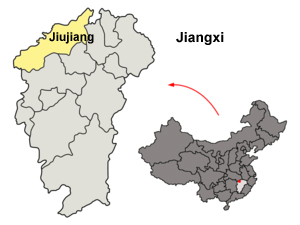 |
| Location of Jiujiang within Jiangxi |
Location: The city of Jiujiang is situated near the northern border of Jiangxi province. It borders the Yangtze River to the north, Poyang Lake to the east and picturesque Mount Lushan to the south. Jiujiang in Chinese means "nine rivers".
Physical Features: Owing to its location at the geographical intersection of Hunan, Hubei and Jiangxi Provinces, Jiujiang was a strategically important city. Because it was virtually at the center of so many bodies of water, the city has been one of the four largest rice markets and one of the three largest tea markets in China. Climate Features: Situated to the south of the Yangtze River, Jiujiang has a subtropical climate. The average annual temperature is 17 ℃ (62.6 ℉). January is the coldest month with a mean temperature of about 5 ℃ (41 ℉), and July is the hottest month with a mean temperature of about 29 ℃ (84.2 ℉).
Demographics: The city administers a total population of approximately 4,500,000, of whom approximately 650,000 are urban. The population density is 235 per square kilometer. Han Chinese make up 99.8% of the population, but registered residents include representatives of 25 minority nationalities, including six with a local population of more than 100: Hui, Miao, Zhuang, Tujia, and She. Unlike the Gan dialects of Jiangxi, the local speech of Jiujiang is a variety of Mandarin.
 |
| Lushan Mountain |
Brief History: In ancient times it was told that nine rivers converged near where Jiujiang sprang up to become Jiangxi's main water port today. During the Xia through the Shang Dynasties Jiujiang was a capitol of several states. In the Spring & Autumn Period (770-476 BC) Jiujiang bordered between the states of Wu (downstream, to the east) and Chu (upstream, to the west).
After becoming an open treaty port in 1862, it was exporting Jiangxi's vast rice crop. It became one of the three centers of the tea trade in China along with Hankou and Fuzhou.
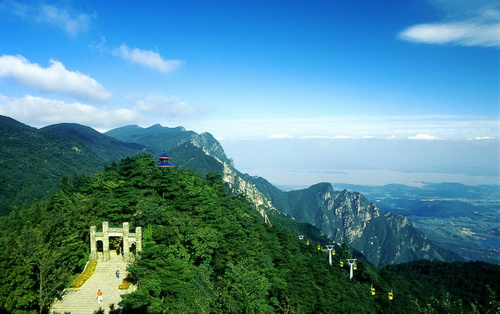 |
| Hanbokou on Lushan Mountain in summer |
When to Go: Since it is sultry and rainy in summer and cold in winter, the best time to visit Jiujiang is in late spring and autumn. However, the situation is different in Mount Lushan, which has four distinct seasons. Therefore it is pleasant to visit anytime, depending on your preference.
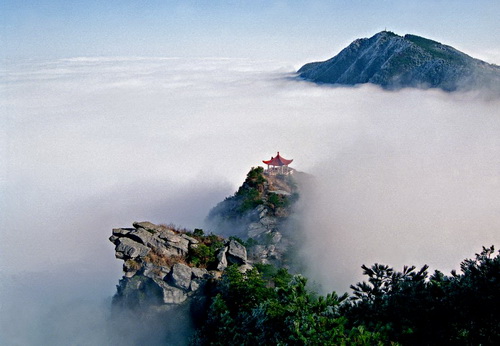 |
| The Little Heaven Pool |
Scenic spots:
With a history of over 2,000 years, Jiujiang is an attractive city boasting of grand mountains and numerous waterways. Cultural relics of Buddhism, Taoism, Islam and Confucianism can be found on nearby Mount Lushan. The mountain also features captivating rock formations, natural springs, temples and stone inscriptions. Most of Its 99 peaks rise over 1,000 meters above sea level.
Poyang Lake located south of Jiujiang is China's largest freshwater lake. It is a habitat rich in aquatic plants and is home to over 100 species of migratory birds. During the winter months visitors can see spectacular flocks of birds in flight. This scene is thought by some to resemble the “second Great Wall of China”.
There are many historical buildings in Jiujiang. Among them are Suojiang Tower, Nengren Temple built in the 6th century, and Wave Well which is nearly 2,000 years old. Gantang Lake located downtown is historically significant as well.
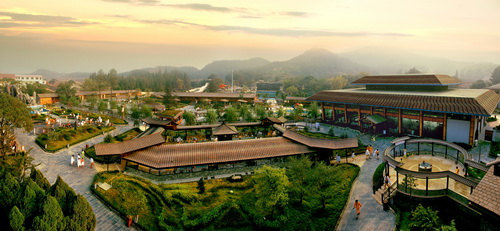 |
| Xingzi Hot Spring |
Travel Tips:
Dependant on the Yangtze River, Jiujiang has been an important port since ancient times. Today, standing in the intersection of the Yangtze River and the Beijing-Jiulong Railway, Jiujiang has well developed land and water transportation routes.
As the junction of the Beijing-Jiulong Railway, Wuhan-Jiujiang Railway, and Hefei-Jiujiang Railway, the Jiujiang Railway Station connects Jiujiang with cities in all parts of China. Everyday, trains starting from or passing by Jiujiang go to most of Chinas major cities.
As for road transportation, five important highways traverse Jiujiang, including the Nanchang-Jiujiang Highway, Jiujiang-Jingdezhen Highway and the No.105 National Highway and No.316 National Highway, forming a large network of roads. Moreover, the Jiujiang Airport offers another transportation option.
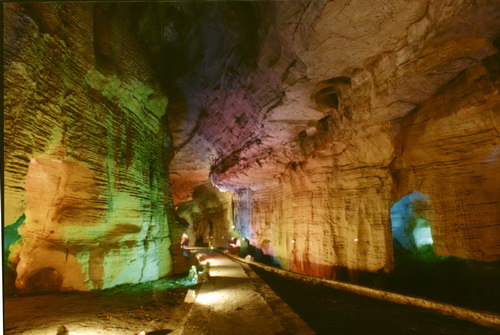 |
| The Dragon Palace |




